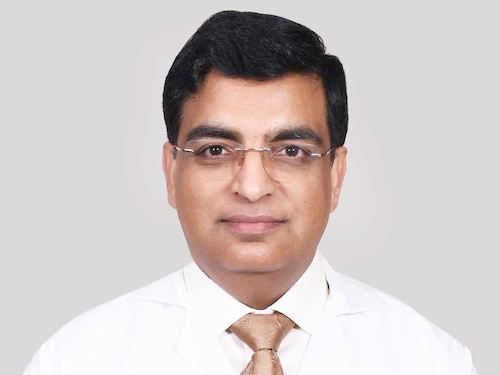Interstitial Cystitis: Painful bladder syndrome
Dr. Rajesh Taneja, MBBS, MS, MCh. (AIIMS), FGSI, Senior Consultant, Urology, Andrology and Robotic Surgery, Indraprastha Apollo Hospitals, New Delhi


 Introduction
Introduction
Interstitial cystitis means inflammation in all the layers of the bladder. Doctors thought that only in this disease they would find inflammation in all the layers, but slowly they realized that other conditions can also mimic a painful bladder. The layers of the bladder are the lamina propria, muscle lamina, and serosa/adventitia. These layers of the bladder get inflamed and that is how the term interstitial cystitis came into knowledge more than a century ago.
Bladder pain syndrome is a much wider term — in this interstitial cystitis along with other disease conditions may be involved. Bladder pain syndrome, or painful bladder syndrome, means that the pain is coming from the bladder. If one has bladder pain syndrome and the cause of inflammation is in all three layers of the bladder, then it becomes interstitial cystitis. There may be other causes that can lead to bladder pain, such as neuropathic pain.
Diagnosis of interstitial cystitis is not easy. Furthermore, hysterectomy is not a treatment option for interstitial cystitis.
Neurologists are trained to treat cancers of the bladder, prostate, kidney, stones in the bladder, kidney, or other urinary diseases, but they have very little (not educated) information on the subject of interstitial cystitis. Some neurologists tried cystoscopy under local anesthesia to diagnose interstitial cystoscopy but didn’t get the desired results.
An individual suffering from pain that cannot be tolerated but goes away when he/she passes urine can be diagnosed with interstitial cystitis. The bladder is like a balloon. If that balloon has an ulcer, when it fills with urine, it pulls the ulcer and causes pain. However, the person is aware that if he urinates, the bladder is temporarily deflated and the pain goes away. Therefore, these patients often go to the washroom as a result (some individuals go to the washroom 60 times in 24 hours). In some cases, the patient"s family did not believe that the patient had a disease (due to a lack of awareness or knowledge about it) and, as a result, the patient developed suicidal ideation.
Effect of pregnancy on interstitial cystitis
Pregnancy is believed to somehow reduce the inflammation of the bladder. It was observed in studies that in patients who had had pain symptoms for at least 2-3 years but became pregnant, their pain symptoms reduced. But after 1.5 years after delivery, their symptoms returned and they needed treatment.
Different diagnostic modalities
The clinical diagnosis is based on history (i.e., the patient has pain in the lower abdomen or external genitalia of the anus or full bladder) — either the pain is relieved on passing urine or not.
Symptoms such as infection in the genitalia, vulvitis infection, erosion, or colitis are excluded during diagnosis. Tuberculosis of the bladder has the same symptoms as interstitial cystitis (burning pain, small capacity bladder, etc.).
The investigation is done by doing a routine urine examination. If the urine has pus cells, leukocytes, or nitrites, then there is a chance of infection. The presence of these means interstitial cystitis is absent.
Ultrasound can help rule out other possibilities, such as a stone in the lower end of the ureter.
Doctors check for hunner lesions to make a diagnosis of interstitial cystitis. These lesions are star-shaped lesions radiating in parallel with capillaries. The lesion is often erythematous with central vascularity and mucosal sloughing.
Doctors may use cystoscopy to look inside the urethra and bladder. A cystoscope is a tube-like instrument used to look for bladder ulcers, cancer, swelling, redness, bleeding spots, and signs of infection. A doctor may perform a cystoscopy to diagnose interstitial cystitis. When doctors perform a cystoscopy, a rain of blood may be seen from all sides of the bladder.
Interstitial cystitis is also a progressive disease. End-stage bladder disease develops quickly in most patients. The end-stage bladder is a thick-walled bladder that has a capacity of <100ml, and can’t be distended under anesthesia — It is a useless bladder from the patient"s perspective (due to not being able to store urine).
If the patient has pain, then doctors do augmentation cystoplasty, but in the case of interstitial cystitis end stage, bladder-pain doctors remove the bladder and do a urinary diversion in the form of an ileal conduit.
Management of interstitial cystitis
Doctors add hydroxyzine (an antihistaminic) to the treatment if there is a history of allergies. When there is neuropathic pain, doctors add tryptomer to the treatment.
If the patient visits the clinic in the initial stages of bladder disease, then doctors generally do repeat hydrodistension, ablation of the lesions, and introducing steroids (such as corticosteroids) into the bloodstream, or a solution of heparin and cortisone works well.
Doctors add hydroxyzine (antihistaminic) to the treatment if there is a history of allergies. When there is neuropathic pain, doctors add tryptomer to the treatment.
Literature reviews suggest that up to 87% of the patients with bladder pain syndrome may have spastic pelvic flow. In these cases, the doctor adds clonazepam and cyclobenzaprine to the treatment.
Family education (so that they can treat well) also plays an important role in improving the quality of life of patients suffering from interstitial cystitis.
A diet plan also plays an important role in the management of interstitial cystitis. Spices or dark chocolate can trigger pain in the patient. In 2019, a book was published which provides information on the Indian diet for interstitial cystitis.
Pelvic floor relaxing exercises can also help in relieving pain symptoms.
First Published: Aug 17, 2022, 10:42
Subscribe Now